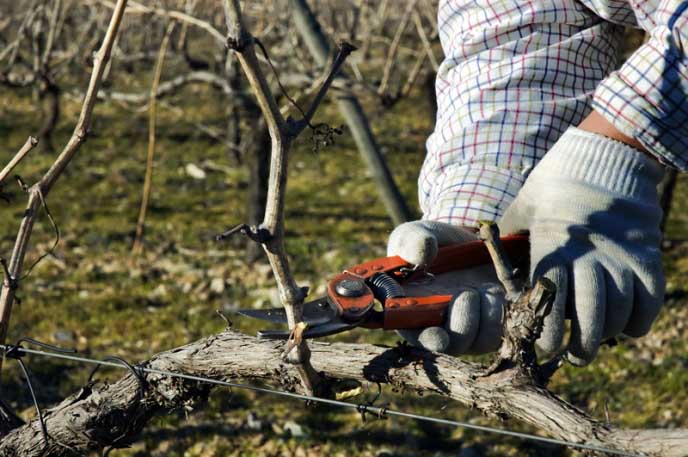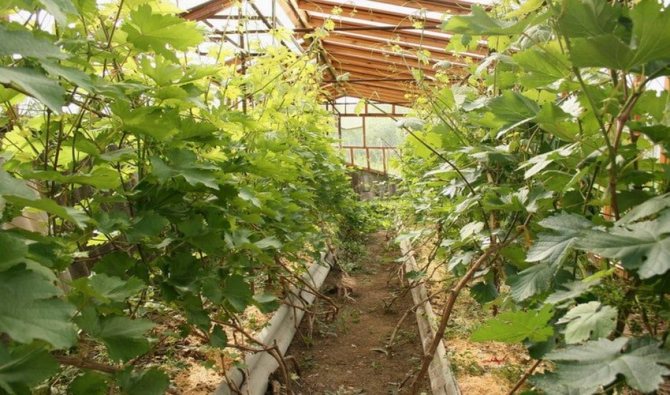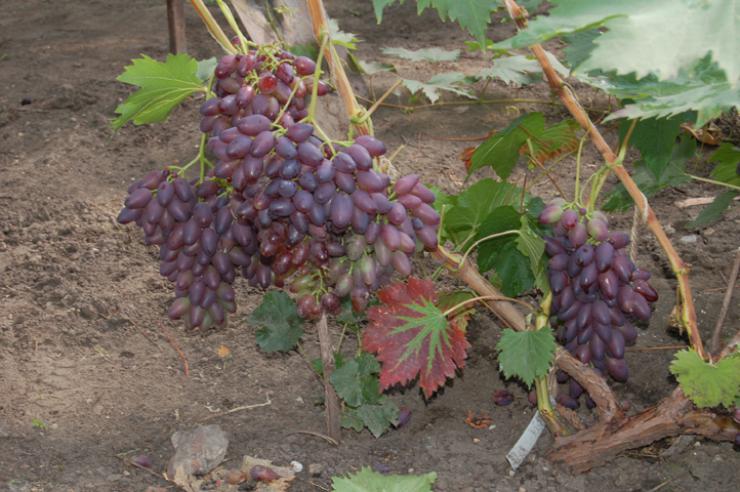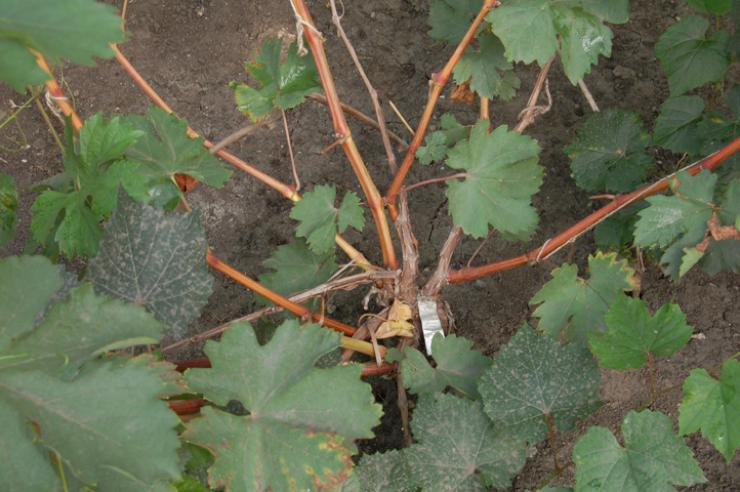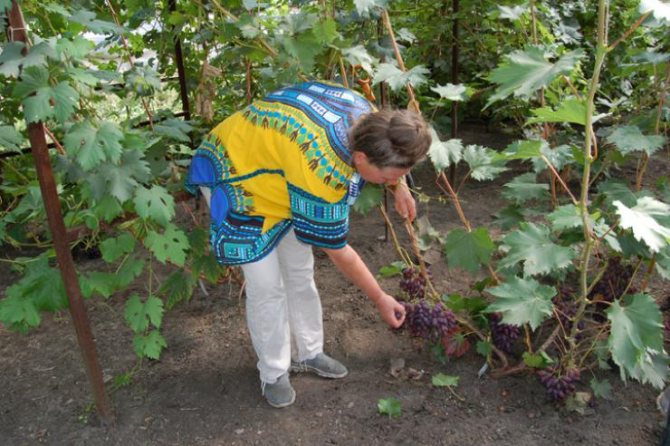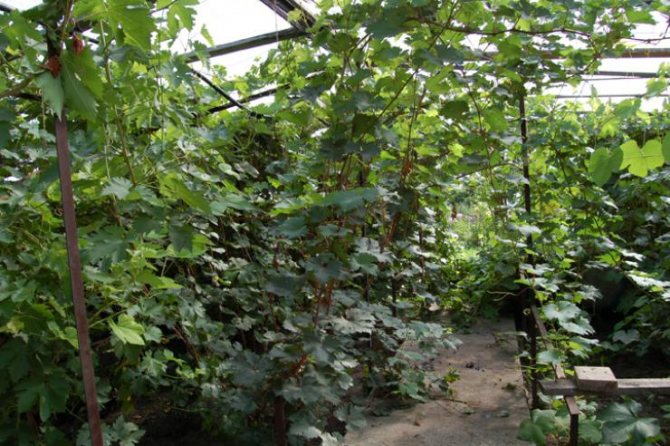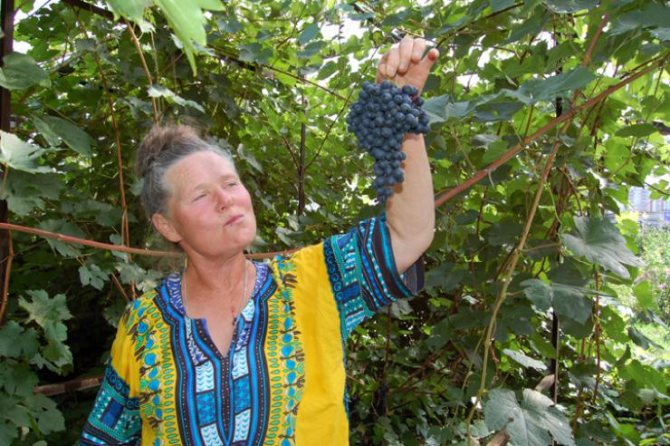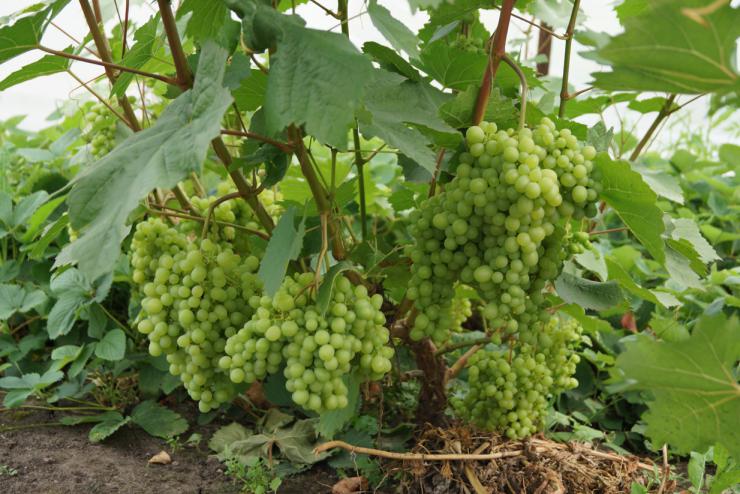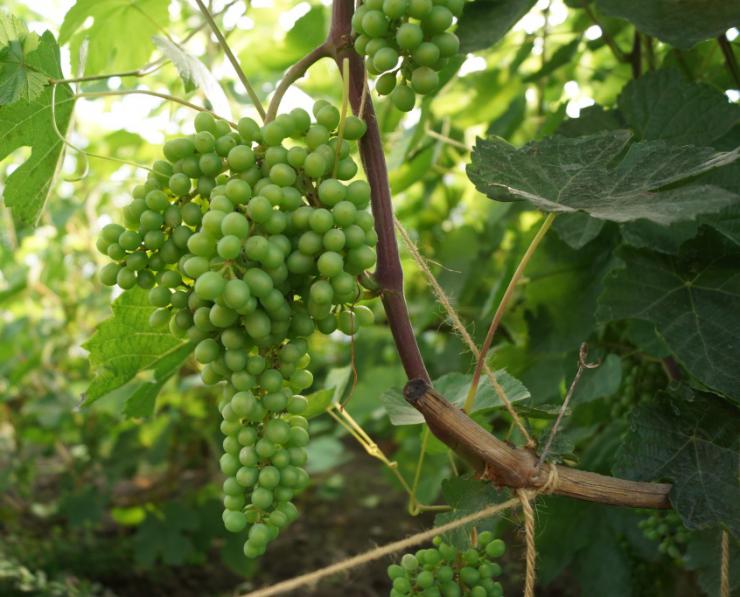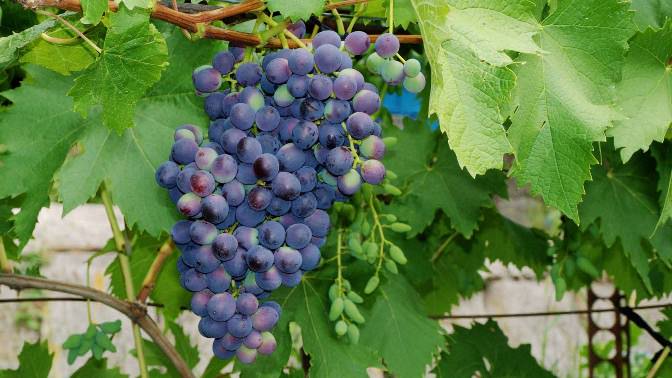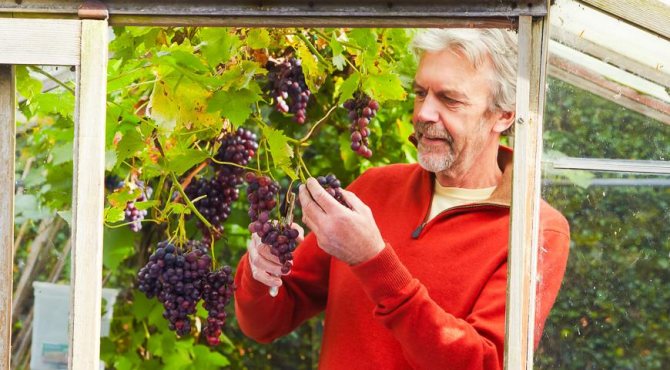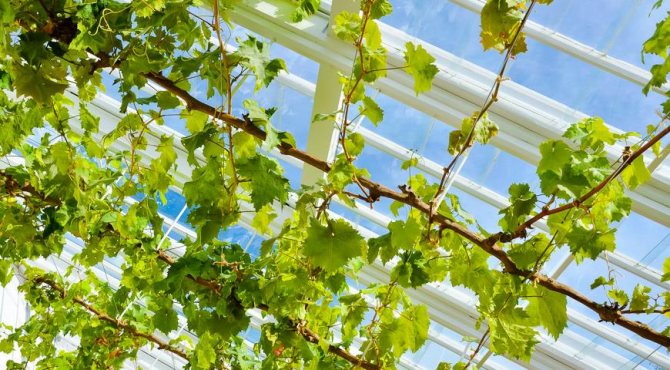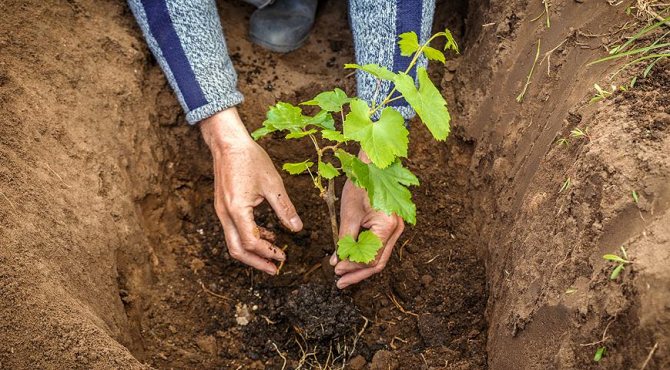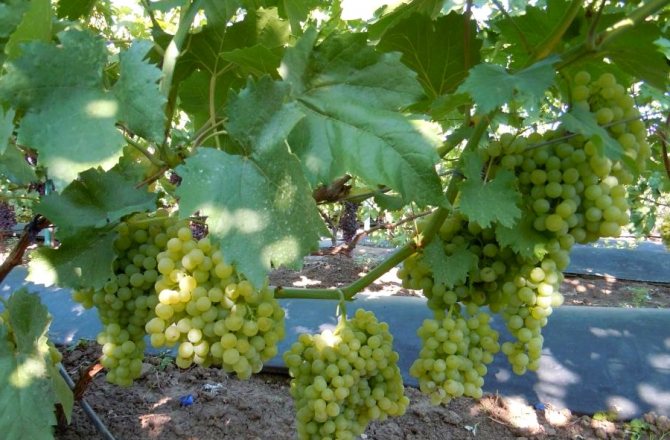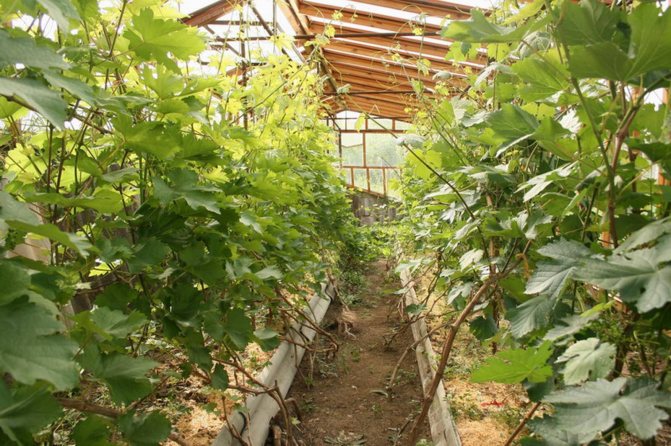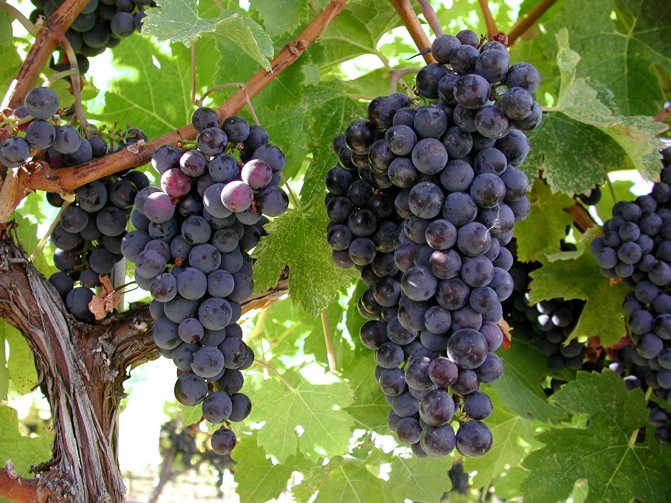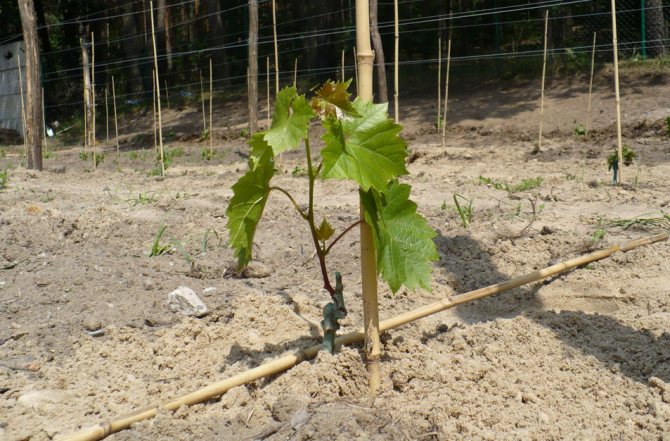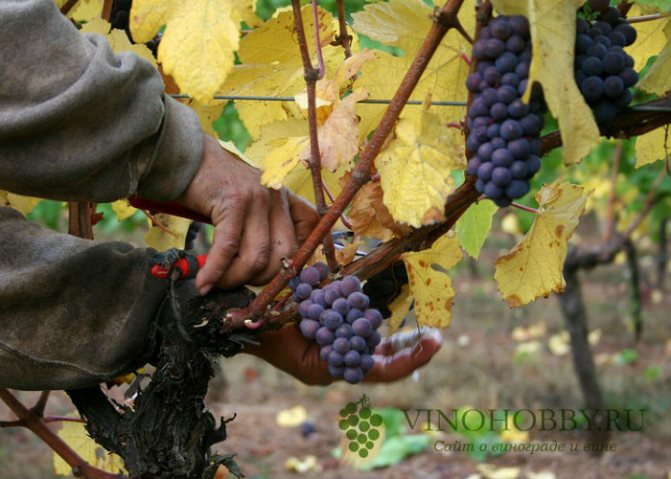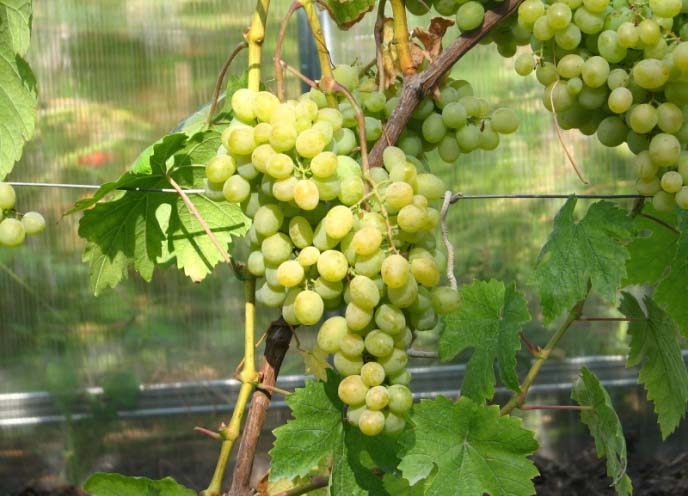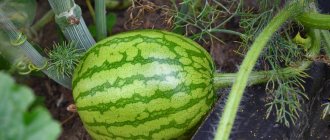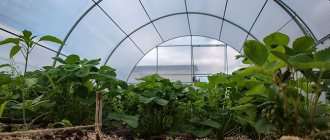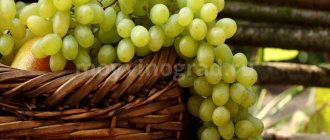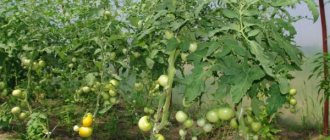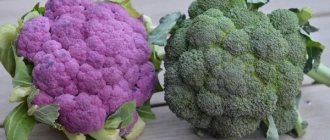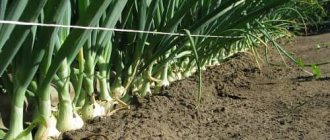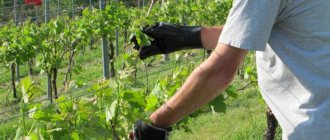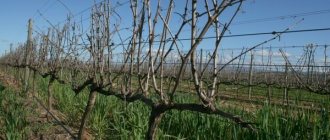I used to be skeptical about growing grapes in Western Siberia. And when winegrowers lectured in our clubs, I never listened to them, because I believed that grapes are not a Siberian culture. Several years ago, at an exhibition, I met a winegrower from the Novosibirsk region, Mikhail Koryagin, and was simply amazed that in Siberia, large-fruited table varieties can be grown, ripe and very tasty. However, I refused to grow grapes in trenches. Instead, she began to successfully grow grapes in a greenhouse.
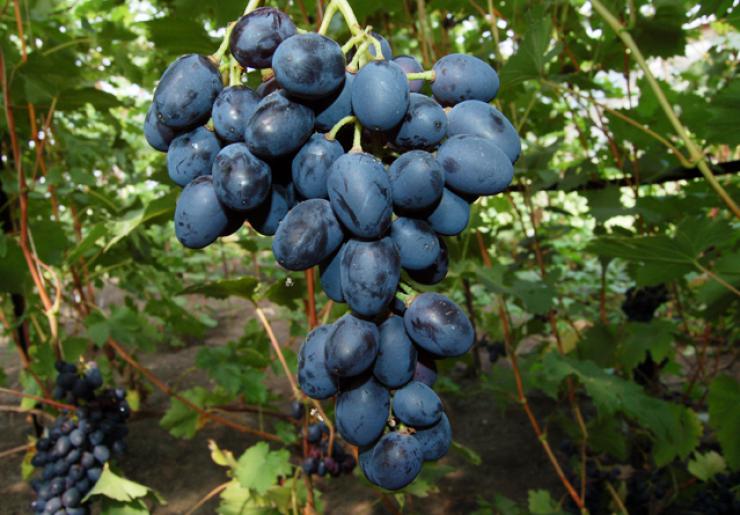
When I read information on the Internet about growing grapes, I met recommendations that under the bushes you need to dig holes 3 m deep, do drainage. In the trench method, the covering process is also quite laborious. The first experience of growing in a trench was not entirely successful. After winter, 30% of my young vines died. If you just imagine all these works, then you immediately lose heart. In fact, everything is much easier if you grow grapes in a greenhouse. I thought: we grow cucumbers and tomatoes in greenhouses and get a good result. So why not do the same with grapes?
Pros and cons of greenhouse planting
Daylight hours in the north are much shorter than in the south. The climate is harsher and more changeable, and the temperatures are not high enough for the berries to ripen. To grow heat-loving shrubs in Siberia or the Urals, one must be puzzled by the construction of a greenhouse. Despite the need, planting grapes in closed ground has its undeniable advantages:
- in the greenhouse, the temperature and humidity can be artificially maintained at the proper level;
- the crop ripens several weeks earlier;
- it is much more convenient to care for the bushes;
- in closed structures, plants are less sick, therefore, chemical treatment is not required;
- less wasps and pests that spoil the crop get into the greenhouse;
- the walls of the structure allow you to avoid damage to the bushes by frost, rain or hail;
- the total mass of the bunches increases.
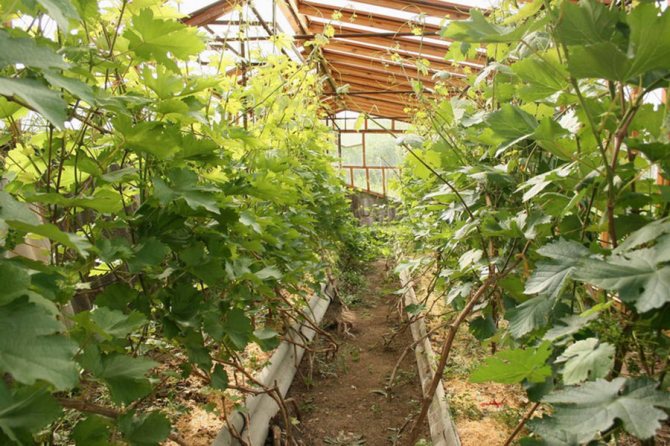

In large greenhouses, other plants can be planted between the grapes, which can grow and develop in the shade.
How to cover a bush for the winter?
When you have harvested from Amur grapes, maiden grapes or any other variety, you must immediately start protecting the bush from the first cold weather:
- Lay a film, a bag on the ground and remove the vines from the support.
- Place them on a bag or plastic wrap.
- Build a tunnel-shaped shelter like a greenhouse on top. To create it, you need polycarbonate.
- This will help the leaves of the plant not to freeze when the first frosts begin, and if the autumn weather in Siberia pleases the Indian summer, then photosynthesis and bud growth will continue in the grapes.
- After the leaves fall off, the structure must be disassembled. At the same time, leaving a film or bag on the ground.
- Start building a new shelter. It will look like a box with sides. Do not forget to leave space for the grapes between the walls so that it can breathe.
- Insulate the sides of the shelter with any suitable material: burlap or cardboard. You can also use Styrofoam and Spunbond.
- Put the film on top so that no water gets inside. For better protection against moisture, you will need slate.
Variety selection
There are several peculiarities in choosing a grape variety for a greenhouse. It is necessary that the plant gives bisexual flowering and does not need additional pollination. Early maturing varieties are preferred. It is also recommended to choose bushes with thin tassels so that light penetrates to each berry and promotes their ripening.
- Planting the table variety "Michurinsky" guarantees an early bountiful harvest. The grapes are disease resistant, have conical clusters and burgundy berries.
- The Laura variety is characterized by early ripening. Large clusters can be up to a kilogram. The berries do not crack and are not afraid of cold weather, they have a light green tint and a pleasant taste.
- "Korinka Russkaya" is frost-resistant and pleases with high yields. The variety belongs to early ripening, is not afraid of fungal diseases. The berries of the variety are not large, but seeds are completely absent in them.
- The table variety "Arcadia" ripens early. The bunches grow up to 700 grams. Large berries are green and do not crack.
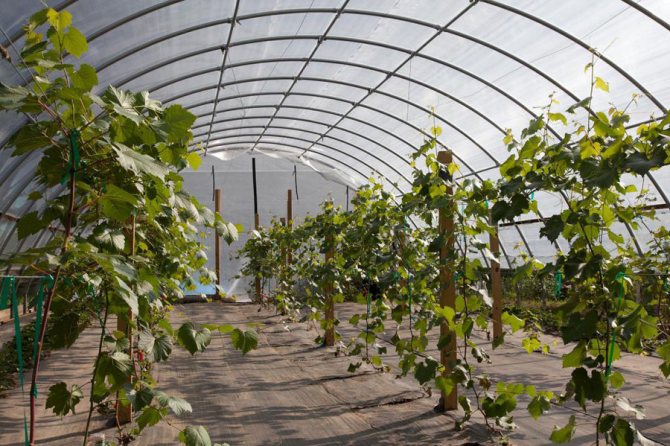

It is recommended to grow in a greenhouse such varieties as: "Ruslan", "Moldova", "Irinka", "Delight". All of them are early maturing and resistant to frost.
How to grow grapes from cuttings
Growing grapes from seeds at home does not always give a good result, and seedlings bought from nurseries or markets may be of inadequate quality. The best option for those who want to get healthy planting material is propagation by cuttings. Plants obtained in this way root well, but preparation and caring for them require certain rules. How to grow grapes from cuttingsfor planting to produce a large amount of green foliage and a rich harvest?
What should be a greenhouse
Greenhouses are often made of polycarbonate. This material does not let the cold through and protects the planting from drafts. Heat and sun rays pass well through it. It is easy to make a greenhouse with your own hands, but for this you need to follow a few simple rules.
- The structure must be at least 2 meters high. It is best to give it an arched shape.
- To prevent the appearance of weeds and pests inside, it is required to raise the structure to a concrete foundation.
- Shelter can be made from film. Such a structure will last one season. Polycarbonate is stronger, so the greenhouse will be well protected in winter.
- The frame must be made strong, since some varieties begin to bear fruit only after 5 years.
- Heating devices can be installed in the greenhouse or equipped with infrared lamps.
- Apart from the heating, the structure is equipped with artificial lighting lamps.
- It is necessary to establish a ventilation system in the greenhouse. If the area is small, then two vents will be enough.
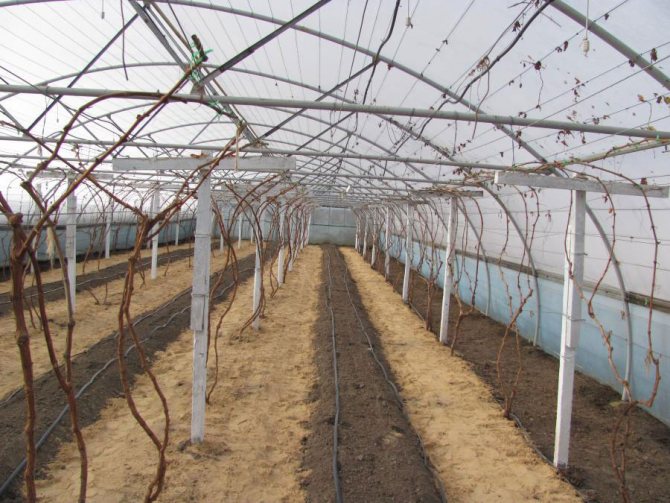

To get large yields, it is necessary to maintain a balance of humidity, temperature and free air movement
Features and basic requirements for the greenhouse
For year-round use, it is better to choose a polycarbonate construction. Given the growth and spreading of the vines, the room should be spacious and appropriately equipped.
Room requirements:
- dimensions - height up to 3 m, area - 25-30 m² (when grown for own needs); for growing fruits for sale, the area is increased according to needs;
- foundation - concrete, tape type is recommended;
- sheathing - cellular polycarbonate is the best option for keeping crops all year round;
- carcass - arched type made of galvanized steel pipe;
- heating - upper (infrared lamps) or subsoil (heating cable);
- lighting - preferably fluorescent lamps with a timer to supplement the grapes in a short daylight;
- ventilation - the presence of vents is required, the number is determined depending on the area of the room.
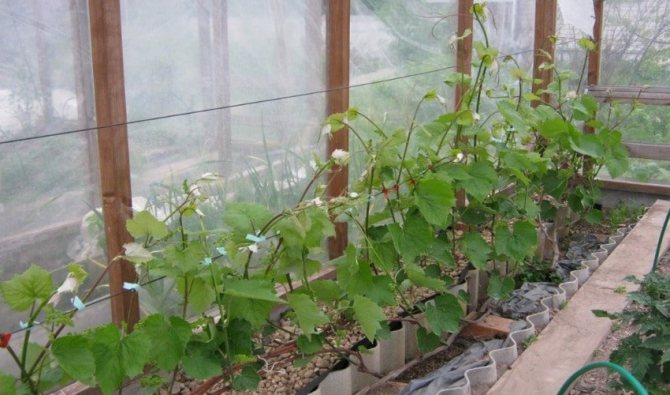

It is recommended to install a fan powered by electricity with a relay and a temperature sensor for automated forced ventilation without the participation of a gardener.
How to prepare a landing site
Before landing, you need to prepare the room. You need to start with the soil, which should be light and fertile. Sandstone, loam, peat, limestone and garden soil must be added to the mixture. It is recommended to add mineral components to the soil. The mixture is poured into pre-prepared grooves or trenches.
At a distance of 40 centimeters from the boundaries of the structure, pull the wire. This is a good precaution against vine burns. When in contact with polycarbonate, heated by the sun's rays, delicate branches deteriorate. The wire limits the stretching of the vine.
Advertisement 1
Greenhouse options for grape trellis
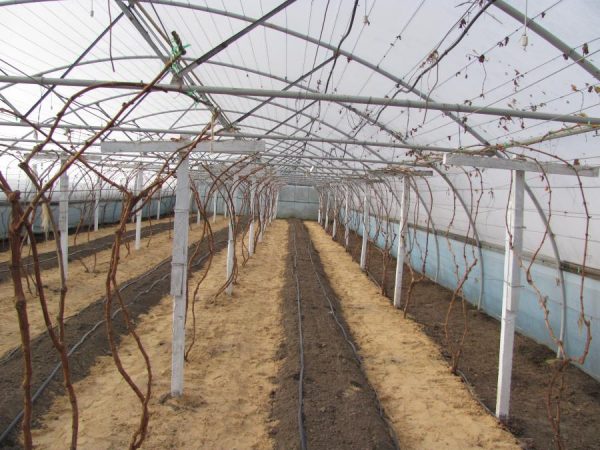

Trellis in a greenhouse for growing grapes
The most used types of trellis, in greenhouse conditions, are usually considered to be single-plane with or without a canopy and trellis with a horizontal arrangement of fruit-bearing vines at about the height of human growth. Although there are no specific restrictions in this regard, the only factor that really affects the choice of the type of tapestry used can be called the greenhouse space.
In any case, the location of the supports should be such that the grape shoots retreat from the walls of the greenhouse at a distance of about 50 cm. Otherwise, otherwise, the threat of burns will inevitably arise.
Growing technology
To get a good harvest, it is necessary to carry out all the care procedures in a timely manner: fertilize, cut and form bushes, water and ventilate. The technology of growing grapes in a greenhouse has its own characteristics and differences from the traditional method.
- It is necessary to plant sprouts in late October or early spring. Planting material must be chosen strong, with a formed root system, without signs of rotting and freezing.
- It is necessary to dig trenches at a distance of 50 centimeters from the walls of the greenhouse. This will protect the vine from contact with the structure.
- A distance of 2 meters is maintained between the shoots.
Benefits of growing grapes in a greenhouse
Growing grapes in a greenhouse, in comparison with open-air beds, has a number of positive aspects.
This planting method is especially suitable for areas with an unstable climate:
- In a closed room it is easier to maintain a given temperature and humidity level. Even without an artificial heater, the room will be 3-4 degrees warmer than outside.
- Subject to all the rules of cultivation and care, the crop can be harvested 3-4 weeks earlier.
- Convenient to care for in any season, easier to harvest.
- Infectious diseases develop less often, so there is no need to treat bushes with chemicals.
- There is no risk of wasps or other insects damaging the mature crop.
- The greenhouse design protects the plant from spring frosts, low temperatures in winter, hail and heavy rains.
- The number of bunches increases significantly.
In the interval between seedlings in the greenhouse, you can plant flowers, vegetables, greens.


Care features
To wait for healthy grown bushes, you need to carefully look after them. A balance of light, humidity and temperature will help to get a good harvest. The subtleties of care are of interest to novice winegrowers. Professionals know that the temperature depends on the growing season of the plant.
- In the spring, when the buds begin to bloom, the thermometer should show 15 degrees. At night, the temperature should not drop below 8.
- At the time of flowering, the vine needs warmth. 25 degrees during the day and 15 at night is the optimal temperature.
- Plants need heat to ripen berries. During this period, the temperature should be increased to 30 degrees during the day and up to 25 degrees at night.
Climate is important, but watering, weeding, fertilizing and loosening are just as important. The most difficult process is pollination. It is best if it occurs naturally with the help of bees. This is not always possible, so you have to resort to artificial methods. Pollination is carried out by gently shaking the flowering branches. It is enough to carry out the manipulation once a day.
Advertisement 2
Harmful insects and infections are less likely to enter the greenhouse. However, treatment should be carried out to prevent gray mold, mildew, anthracnose, leafworm and ticks. For these purposes, a soap solution or the recommended chemicals are suitable.
Newbies are wondering if it is possible not to cover the vine in an unheated greenhouse. This is not recommended. The branches are removed from the supports in mid-October, attached to the ground and covered with insulation. For these purposes, you can use sawdust, roofing felt or spruce branches.
Pruning
To increase the yield, it is necessary to carry out the formation of the bush annually. This procedure allows you to leave only healthy shoots, to give access to light to the lowest bunches. Thanks to the shaping, the bushes become more neat. The procedure prevents the spread of infections, contributes to a more abundant harvest.
Dry and damaged processes should be removed regularly. It is also necessary to get rid of weak shoots.
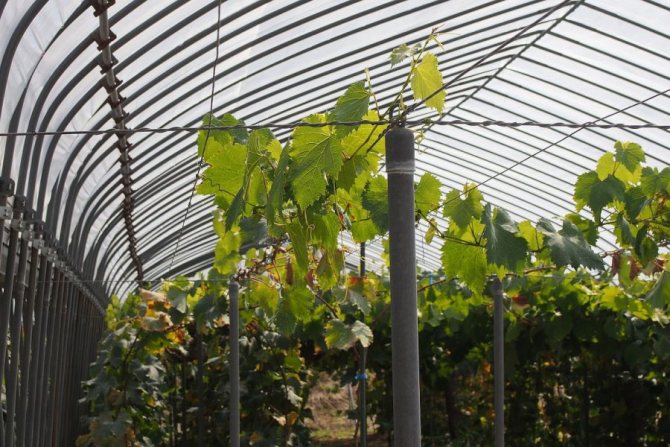

Barren shoots must be removed up to 5 leaves. This will make it possible for a strong vine to give more bunches, and useful trace elements will not be spent on greens.
There is an optimal scheme for trimming:
- the strongest and healthiest shoot stands out, which will become the basis of the bush;
- it must be cut off, leaving 3-4 eyes;
- when next season 2 new shoots appear from each bud, they must be cut off by 3 eyes and by 8-9;
- it is recommended to form a bush from the lower branches.
Advertisement 3
Top dressing
An important stage in plant care is feeding. Mineral and chemical fertilizers give the grapes strength for the growth and development of bunches. Pests and diseases attack healthy, strong bushes much less often.
It is necessary to feed the plants in several stages:
- potassium, phosphorus and nitrogen must be added during the planting of the shoots;
- 14 days before flowering recommends using organics with the addition of superphosphate and potassium sulfate;
- when berries are formed, more phosphorus and potassium are required to be added to the mixture;
- at the time of ripening, feeding is also necessary, but it is better to limit ourselves to organic matter.
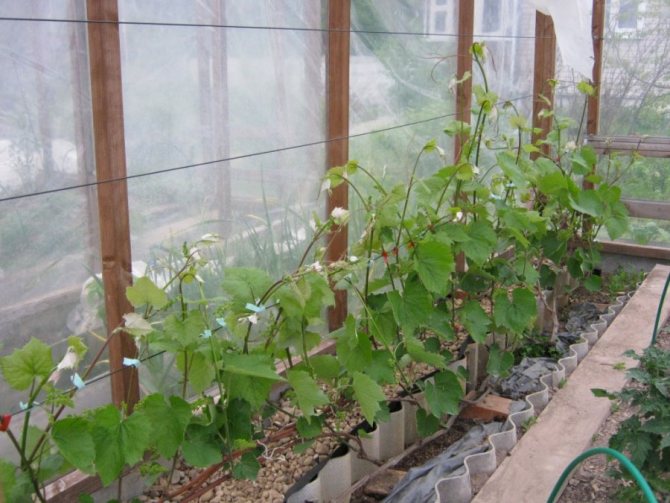

When buds are just beginning to appear, ammonium nitrate must be added so that the bush grows green mass. Lush bloom will support superphosphate
Nutrient mixes are poured into grooves near the main trunk. The liquid should not fall on the leaves, so as not to burn them.
Watering subtleties
The grapes do not tolerate waterlogging, therefore, great importance is attached to the drainage system. At the planting stage, tubes are placed in the holes through which you can water the bushes. It is not recommended to moisturize the soil too much. This will lead to cracking of the fruit and rotting of the roots.
Watering is done in grooves dug around the vine. The first moistening should be done before planting. 20 liters of water is poured onto the hole, after which mulching is carried out. Secondary watering is carried out in a week.
In hot weather, humidification is performed weekly. The amount of water must be reduced at the time of ripening so that the berries do not rot and crack. Watering in the greenhouse is done only in the morning. In the evening, moisture does not go anywhere, and the air becomes excessively humid. This can lead to rotting roots, shoots and fruits. Water should be used only with settled water. It should be almost hot in the spring. The rest of the time, warm water is used.
Grapes are a very picky plant.If you neglect the elementary rules of planting, care and pruning, then you will not be able to achieve a large harvest. Only an integrated approach allows you to grow healthy fruit-bearing plants. At the same time, one should not forget about the creation of greenhouse conditions. Constant control of temperature, light and humidity is the key to success.
When and what is the best way to feed?
Traditionally, grapes are fed four times per season:
- In the spring, arrange a groove around each bush and add 40 g of superphosphate, 30 g of potash fertilizers and 50 g of nitrogen fertilizers to it. Cover everything with soil. At the same time, you can add a liquid top dressing - dissolve 50 g of fertilizer in 10 liters of water and pour into the hole like this: first, a 10-liter bucket of warm water, and then the prepared solution, and then water again. Once the soil dries up, loosen it up to 10 cm.
- Exactly two weeks before flowering, add an aqueous solution of the same fertilizers to each bush or specially prepare the following: dilute a bucket of slurry with two buckets of water and leave the queen to ferment in a buried barrel for days. Dilute the ready-made solution 6 times. Additionally, you can add potash fertilizers 20 grams and the same amount of superphosphate - all this for one bucket of water. Water one bucket around each bush.
- When the berries are the size of a pea, repeat the last dressing. It is only important to calculate so that fertilizers do not turn out to be more than 30 g per 10 liter bucket.
- When the berries begin to ripen, add 50 g of phosphorus and potassium fertilizers to the bucket of water again, and water all this around the perimeter of the plants. Just do not experiment with nitrogen fertilizer at this time. But, if you have wood ash, you can use it as a potassium supplement.
If you correctly use the above feeding scheme, your grape harvest will turn out to be 2 times larger than before, and the berries will have a gorgeous presentation.
Northern viticulture technologies (video)
Despite the difficulties associated with the cultivation of grapes in Siberia in the open field, many experienced winegrowers in the region successfully grow the most suitable varieties outside of greenhouses.
| Variety name for open ground | Description of the plant | Description of the berry | Features of the variety |
| "Beauty of the North" | Obtained from crossing the varieties "Zarya Severa" and "Taifi rosy". Very early ripening period. Bushes vigorous, clusters are large, loose or medium density, conical or branched, weighing up to 255 g | The berries are large, slightly oval, whitish with a pink tint. The skin is thin and firm. The pulp of the berries is fleshy, juicy | Resistant to gray mold and berry cracking. Frost resistance up to -25 ° С |
| "Swallow" | The variety is obtained from crossing the grapes "Madeleine Angevin" and "Kokur red". Very early maturation. Bushes of medium height, bisexual flowering. Cylindrical-conical brushes, weight 325 g | The berries are medium, slightly oval, dark blue. The skin is thin. The pulp is fleshy, juicy | The plant is often attacked by wasps. Frost resistance is sufficient |
| "Muromets" | The variety is obtained from crossing the grapes "Severny" and "Pobeda". Very early ripening table variety. The bushes are vigorous. The flower is bisexual. Brushes are large, conical, medium in density | The berries are large, oval, dark purple. The pulp is fleshy, crispy. The waxy coating is quite thick | High resistance to mildew damage, susceptibility to mildew damage. Frost resistance up to -25 ° С |
| "Zilga" | A universal variety with a very early ripening period. The bushes are vigorous. The brushes are dense, large, cylindrical, with a wing. Average weight up to 410 g | The berries are large, weakly oval, black and blue. The pulp is slimy. Tasting score 7.1 points | Resistant to mildew, oidium, gray mold. Frost resistance up to -26 ° С |
| "Solovyova-58" | Obtained from crossing the varieties "Gaillard-157" and "Pearl Saba".Canteen, with an early ripening period. The bush is medium-sized. The bunches are very loose or loose, small, cylindrical-conical. | The berries are medium, round, white with a grayish-golden tan. Flavor with nutmeg | Resistant to mildew and rot. Frost resistant |
Novice winegrowers are advised to grow this thermophilic and rather capricious crop using own-rooted seedlings in protected ground conditions.


| Indoor variety name | Description of the plant | Description of the berry | Features of the variety |
| "Tukai" | Table variety of very early ripening period. The bush is vigorous. The flower is bisexual. The brushes are of medium density, large, cylindrical-conical, winged. Average weight 850 g | Berries are medium, round, white, with seeds | To mildew, oidium unstable |
| "Rusven" | Very early maturation. The bushes are vigorous. Medium-dense or dense brushes, large, cylindrical-conical, with an average weight of up to 550 g | The berries are large, round, matte pink. The pulp is juicy and sweet | Resistant to mildew, powdery mildew. Frost resistance up to -25 ° С. |
| "Amirkhan" | Canteen, early ripening. The bush is vigorous. The flower is bisexual. Brushes are dense, large, cylindrical-conical, weighing up to 850 g | The berries are large, oval, pink in color. The taste is simple, pleasant, with a slight nutmeg | Average frost resistance. The variety can be affected by gray mold |
| "Delight" | Canteen form of early ripening. The bush is medium-sized. The flowers are functionally feminine. Brushes are loose, large, conical in shape, weighing up to 830 g | The berries are very large, oval or ovoid, pink, reddish in the sun. The skin is thin. The pulp is fleshy. The taste is very pleasant and harmonious | Resistant to mildew, powdery mildew, gray mold. Frost resistance up to -25 ° С |
| "Kara jijigi" | The bush is vigorous. The flower is bisexual. Medium or loose brushes, medium, tapered | The berries are small, ovoid or round-oval, black. The skin is thick and firm. The pulp is fleshy, juicy | Frost resistance is insufficient. The variety is strongly affected by powdery mildew |
Soil preparation
When preparing the soil, it is worth knowing that the root system of the grapes is located in its upper layers. Therefore, this layer must be well-drained and fertilized, capable of retaining enough moisture and heat. This is achieved by mixing the total volume of earth with fine gravel and sand. Sand with gravel crumbs should make up about 50% of the total soil. Before planting, the soil is fertilized without fail; for this, mineral fertilizers are selected that contribute to the healthy and rapid ripening of the buds, the growth of the vine and the saturation of the soil with the necessary minerals.
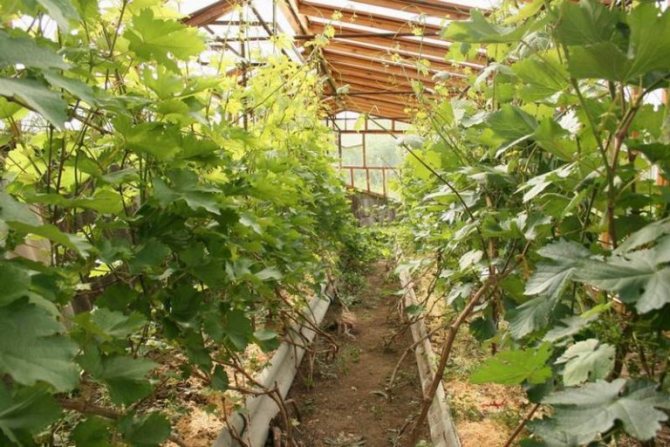

To grow this crop in Siberia, the soil is mulched, covered with a special film that prevents the growth of weeds and additionally retains the heat of the earth. For bushes, holes are cut in black film, usually two or three rows are prepared, the distance between the bushes is kept at least one meter. Varieties for planting in Siberia are chosen mainly without seeds, such as Kishmish, Irinka, Korinka Russian, Aleshenka and some Sidlis varieties.
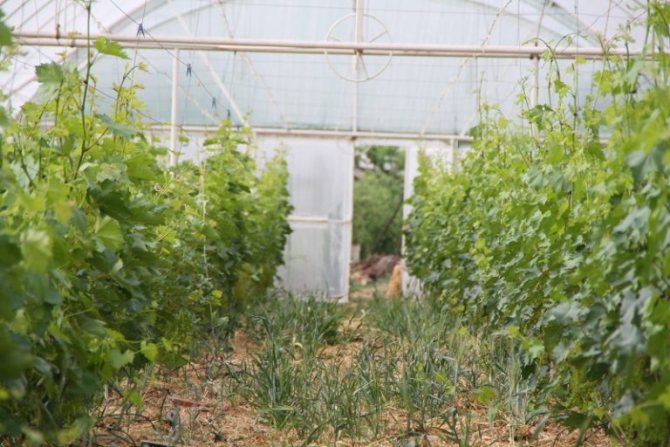

How to build a polycarbonate greenhouse with your own hands
It is impossible to grow grapes without support. To grow normally, the vine needs support.
Vertical
The tapestries are placed at a distance of 2-3 meters from each other. The diameter of the pillar is 5 to 20 cm in diameter. The first and last pillars should be the strongest, they carry the most loads. To install the support, pits are dug up to 1.5 m deep.Then strong ropes are fixed on them. The lower one is at a height of 40 cm from the ground.
T-shaped
The height of this type of support is 150 cm. Strong pillars are driven into the ground along the edges with a partition at the top in the shape of the letter T. Then ropes are nailed to them.
Knowing the features of greenhouses for grapes, you can make a suitable design yourself.This approach, in contrast to the acquisition of ready-made options, will allow you to create the most convenient building and equip it as needed.
When designing a future building, it is necessary to determine the size and shape of the structure, as well as the materials from which the main elements of the greenhouse will be made. The area of construction depends on how much grapes are planned to be planted. The recommended greenhouse height is two and a half meters. However, for some grape varieties, lower designs are also suitable.
For the construction of an arched structure made of polycarbonate, the size of straight walls can be 4.2x1.5 m. The height of the greenhouse in a particular case will be 1.5 m. The width of the building will depend on the slope of the roof. In addition to arched forms, a rectangular structure with a gable roof is well suited for grapes. This option can be assembled from wooden beams and one hundredth polycarbonate.
Foundation
It is recommended to build a foundation before building a greenhouse. The most common option is a shallow strip foundation. The disadvantage of this solution is the high probability of a bad effect on the vineyard root system. A concrete foundation can restrict the spread of plant roots in breadth.
At the bottom of the corners, small thick support plates made of iron are welded. A large greenhouse may require 14 of these support pins for perimeter placement and about 7 for a central installation.
Frame
For the construction of the frame, materials such as metal or wood are suitable. Working with wooden beams is much easier, since no welding is required. However, this material is inferior in many characteristics to metal. The best option is a galvanized profile frame.
Cultivation rules in open ground conditions
When growing winter-hardy and early grape varieties, zoned for cultivation in Siberia, some agrotechnical requirements should be adhered to:
- an ordinary vineyard planting in open ground should be located in the direction from north to south;
- it is also recommended to place grape plantings along the southern walls of buildings or blank fences;
- the standard distance between the rows should be at least one and a half meters, but can be increased to two meters when the landings are located from east to west;
- it is necessary to adhere to the distance from buildings to the vineyard in meter, which allows to increase the area of plant nutrition and facilitates the maintenance of the vineyard.
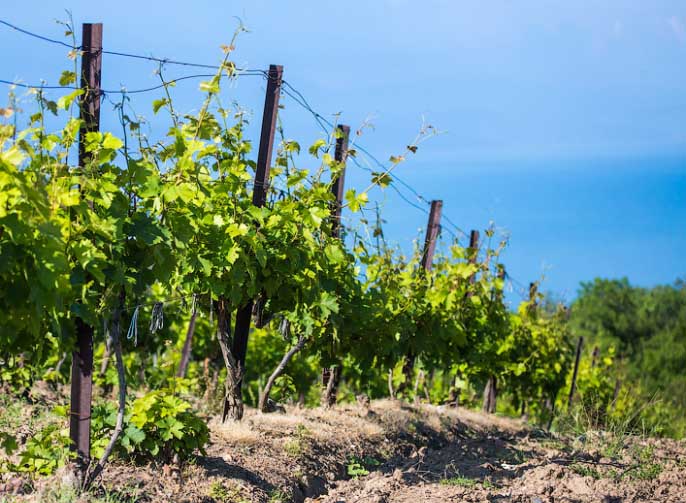

You should stock up on a film or non-woven covering material, as well as arcs that are installed over grape bushes with the threat of spring frosts.
Autumn pruning is carried out in two stages. The first pruning is done between mid-August and late September. During this period, the fruiting vine and the thinnest and weakest branches are removed. The second pruning creates a fruit link or replacement knot.
After reading the corresponding article on our resource, you can learn how to properly prepare grapes for winter.
